Notes
Chapter 12: The Principle of Computational Equivalence
Section 1: Basic Framework https://www.wolframscience.com/nks/chap-12--the-principle-of-computational-equivalence--notes#sect-12-1--basic-framework
https://www.wolframscience.com/nks/chap-12--the-principle-of-computational-equivalence--notes#sect-12-1--basic-framework
Section 2: Outline of the Principle https://www.wolframscience.com/nks/chap-12--the-principle-of-computational-equivalence--notes#sect-12-2--outline-of-the-principle
https://www.wolframscience.com/nks/chap-12--the-principle-of-computational-equivalence--notes#sect-12-2--outline-of-the-principle
Section 3: The Content of the Principle https://www.wolframscience.com/nks/chap-12--the-principle-of-computational-equivalence--notes#sect-12-3--the-content-of-the-principle
https://www.wolframscience.com/nks/chap-12--the-principle-of-computational-equivalence--notes#sect-12-3--the-content-of-the-principle
Character of [general] principles [in science]
Oracles [for universal systems]
Initial conditions [as oracles]
Criteria for universality [in systems]
History [of universal objects]
Section 4: The Validity of the Principle https://www.wolframscience.com/nks/chap-12--the-principle-of-computational-equivalence--notes#sect-12-4--the-validity-of-the-principle
https://www.wolframscience.com/nks/chap-12--the-principle-of-computational-equivalence--notes#sect-12-4--the-validity-of-the-principle
Section 5: Explaining the Phenomenon of Complexity https://www.wolframscience.com/nks/chap-12--the-principle-of-computational-equivalence--notes#sect-12-5--explaining-the-phenomenon-of-complexity
https://www.wolframscience.com/nks/chap-12--the-principle-of-computational-equivalence--notes#sect-12-5--explaining-the-phenomenon-of-complexity
Section 6: Computational Irreducibility https://www.wolframscience.com/nks/chap-12--the-principle-of-computational-equivalence--notes#sect-12-6--computational-irreducibility
https://www.wolframscience.com/nks/chap-12--the-principle-of-computational-equivalence--notes#sect-12-6--computational-irreducibility
History [of computational irreducibility]
Amount of computation [and computational irreducibility]
More complicated rules [and reducibility]
[Examples of] reducible systems
[Computation of] mathematical functions
Formulas [and computational irreducibility]
Section 7: The Phenomenon of Free Will https://www.wolframscience.com/nks/chap-12--the-principle-of-computational-equivalence--notes#sect-12-7--the-phenomenon-of-free-will
https://www.wolframscience.com/nks/chap-12--the-principle-of-computational-equivalence--notes#sect-12-7--the-phenomenon-of-free-will
Section 8: Undecidability and Intractability https://www.wolframscience.com/nks/chap-12--the-principle-of-computational-equivalence--notes#sect-12-8--undecidability-and-intractability
https://www.wolframscience.com/nks/chap-12--the-principle-of-computational-equivalence--notes#sect-12-8--undecidability-and-intractability
Undecidability in cellular automata
[Undecidability in] natural systems
Undecidability in tiling problems
Computational complexity theory
History [of computational complexity theory]
Lower bounds [on computational complexity]
Functions [computed by Turing machines]
Properties [of example Turing machines]
Longest halting times [in Turing machines]
Growth rates [of halting times]
[NP completeness in] natural systems
Non-deterministic Turing machines
Implementation [of TM cellular automaton]
Satisfiability [emulating Turing machines]
[Intractability in] systems of limited size
Section 9: Implications for Mathematics and Its Foundations https://www.wolframscience.com/nks/chap-12--the-principle-of-computational-equivalence--notes#sect-12-9--implications-for-mathematics-and-its-foundations
https://www.wolframscience.com/nks/chap-12--the-principle-of-computational-equivalence--notes#sect-12-9--implications-for-mathematics-and-its-foundations
History [of concept of mathematics]
[History of] models of mathematics
Implementation [of proof example]
Substitution strategies [in proofs]
One-way transformations [as axioms]
Reducing axiom [system] details
[Mathematical] proofs in practice
Properties [of example multiway systems]
Truth and falsity [in formal systems]
Properties [of example multiway systems]
Essential incompleteness [in axiom systems]
[Universality of] predicate logic
[Universality of] algebraic axioms
Universal Diophantine equation
Statements in Peano arithmetic
[Examples of] unprovable statements
Encodings of arithmetic [by different operations]
Properties [of Diophantine equations]
Large solutions [to Diophantine equations]
Nearby powers [and integer equations]
Unsolved problems [in number theory]
More powerful axioms [for mathematics]
[Theorems about] practical programs
Rules [for multiway systems examples]
Consistency [in axiom systems]
Properties [of example multiway systems]
[Unprovable statements in] reduced arithmetic
Generators and relations [and axiom systems]
Comparison to multiway systems
Implementation [of operators from axioms]
Properties [of operators from axioms]
Algebraic systems [and operator systems]
Symbolic systems [and operator systems]
Groups and semigroups [and operator systems]
Forcing of operators [by axiom systems]
Multiway systems [and operator systems]
Properties [of logical primitives]
Notations [for logical primitives]
Theorem distributions [in standard mathematics]
Invention versus discovery in mathematics
Section 10: Intelligence in the Universe https://www.wolframscience.com/nks/chap-12--the-principle-of-computational-equivalence--notes#sect-12-10--intelligence-in-the-universe
https://www.wolframscience.com/nks/chap-12--the-principle-of-computational-equivalence--notes#sect-12-10--intelligence-in-the-universe
History [of extraterrestrial life]
[Ideas of] meaning in programs
Forms of [engineered] artifacts
[Meaning in] molecular biology
Possible purposes [for systems]
Doubling rules [cellular automata]
Searching [for doubling rules]
Properties [of doubling rules]
[Rules implementing] other functions
Minimal cellular automata for sequences
Other examples [of minimal systems]
Higher perception and analysis
Messages to send [to extraterrestrials]
Science fiction [and extraterrestrials]
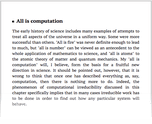
![Note for mathematicians [about PCE] Note for mathematicians [about PCE]](/https/www.wolframscience.com/nks/img/thumbnails/notes-12-2--note-for-mathematicians-about-pce--textonly.png)
![History [of PCE] History [of PCE]](/https/www.wolframscience.com/nks/img/thumbnails/notes-12-2--history-of-pce--textonly.png)
![[History of] Church's Thesis [History of] Church's Thesis](/https/www.wolframscience.com/nks/img/thumbnails/notes-12-2--history-of-churchs-thesis--textonly.png)
![Character of [general] principles [in science] Character of [general] principles [in science]](/https/www.wolframscience.com/nks/img/thumbnails/notes-12-3--character-of-general-principles-in-science--textonly.png)
![Oracles [for universal systems] Oracles [for universal systems]](/https/www.wolframscience.com/nks/img/thumbnails/notes-12-3--oracles-for-universal-systems--textonly.png)
![Initial conditions [as oracles] Initial conditions [as oracles]](/https/www.wolframscience.com/nks/img/thumbnails/notes-12-3--initial-conditions-as-oracles--textonly.png)
![Criteria for universality [in systems] Criteria for universality [in systems]](/https/www.wolframscience.com/nks/img/thumbnails/notes-12-3--criteria-for-universality-in-systems--textonly.png)
![Encodings [for universality] Encodings [for universality]](/https/www.wolframscience.com/nks/img/thumbnails/notes-12-3--encodings-for-universality--textonly.png)
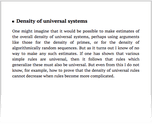
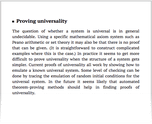
![History [of universal objects] History [of universal objects]](/https/www.wolframscience.com/nks/img/thumbnails/notes-12-3--history-of-universal-objects--textonly.png)
![[Construction of] universal objects [Construction of] universal objects](/https/www.wolframscience.com/nks/img/thumbnails/notes-12-3--construction-of-universal-objects--textonly.png)
![Block occurrences [in rule 30] Block occurrences [in rule 30]](/https/www.wolframscience.com/nks/img/thumbnails/notes-12-3--block-occurrences-in-rule-30--textonly.png)




![Initial conditions [and continuity] Initial conditions [and continuity]](/https/www.wolframscience.com/nks/img/thumbnails/notes-12-4--initial-conditions-and-continuity--textonly.png)

![[Universality in] equations [Universality in] equations](/https/www.wolframscience.com/nks/img/thumbnails/notes-12-4--universality-in-equations--textonly.png)
![[Time compression in] ODEs [Time compression in] ODEs](/https/www.wolframscience.com/nks/img/thumbnails/notes-12-4--time-compression-in-odes--textonly.png)
![Emulating discrete systems [with continuous ones] Emulating discrete systems [with continuous ones]](/https/www.wolframscience.com/nks/img/thumbnails/notes-12-4--emulating-discrete-systems-with-continuous-ones--textonly.png)

![Human thinking [and PCE] Human thinking [and PCE]](/https/www.wolframscience.com/nks/img/thumbnails/notes-12-4--human-thinking-and-pce--textonly.png)




![History [of computational irreducibility] History [of computational irreducibility]](/https/www.wolframscience.com/nks/img/thumbnails/notes-12-6--history-of-computational-irreducibility--textonly.png)
![[History of] exact solutions [History of] exact solutions](/https/www.wolframscience.com/nks/img/thumbnails/notes-12-6--history-of-exact-solutions--textonly.png)
![Amount of computation [and computational irreducibility] Amount of computation [and computational irreducibility]](/https/www.wolframscience.com/nks/img/thumbnails/notes-12-6--amount-of-computation-and-computational-irreducibility--textonly.png)
![More complicated rules [and reducibility] More complicated rules [and reducibility]](/https/www.wolframscience.com/nks/img/thumbnails/notes-12-6--more-complicated-rules-and-reducibility--textonly.png)
![[Examples of] reducible systems [Examples of] reducible systems](/https/www.wolframscience.com/nks/img/thumbnails/notes-12-6--examples-of-reducible-systems--textonly.png)

![[Computation of] mathematical functions [Computation of] mathematical functions](/https/www.wolframscience.com/nks/img/thumbnails/notes-12-6--computation-of-mathematical-functions--textonly.png)
![Formulas [and computational irreducibility] Formulas [and computational irreducibility]](/https/www.wolframscience.com/nks/img/thumbnails/notes-12-6--formulas-and-computational-irreducibility--textonly.png)
![[Examples of] short computations [Examples of] short computations](/https/www.wolframscience.com/nks/img/thumbnails/notes-12-6--examples-of-short-computations--textonly.png)

![History [of ideas about free will] History [of ideas about free will]](/https/www.wolframscience.com/nks/img/thumbnails/notes-12-7--history-of-ideas-about-free-will--textonly.png)
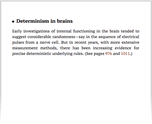

![Responsibility [and free will] Responsibility [and free will]](/https/www.wolframscience.com/nks/img/thumbnails/notes-12-7--responsibility-and-free-will--textonly.png)
![[Free] will and purpose [Free] will and purpose](/https/www.wolframscience.com/nks/img/thumbnails/notes-12-7--free-will-and-purpose--textonly.png)
![Source of [free] will Source of [free] will](/https/www.wolframscience.com/nks/img/thumbnails/notes-12-7--source-of-free-will--textonly.png)
![History [of undecidability] History [of undecidability]](/https/www.wolframscience.com/nks/img/thumbnails/notes-12-8--history-of-undecidability--textonly.png)






![[Undecidability in] natural systems [Undecidability in] natural systems](/https/www.wolframscience.com/nks/img/thumbnails/notes-12-8--undecidability-in-natural-systems--textonly.png)






![[Classes of] fast algorithms [Classes of] fast algorithms](/https/www.wolframscience.com/nks/img/thumbnails/notes-12-8--classes-of-fast-algorithms--textonly.png)


![History [of computational complexity theory] History [of computational complexity theory]](/https/www.wolframscience.com/nks/img/thumbnails/notes-12-8--history-of-computational-complexity-theory--textonly.png)
![Lower bounds [on computational complexity] Lower bounds [on computational complexity]](/https/www.wolframscience.com/nks/img/thumbnails/notes-12-8--lower-bounds-on-computational-complexity--textonly.png)

![[One-sided] Turing machines [One-sided] Turing machines](/https/www.wolframscience.com/nks/img/thumbnails/notes-12-8--one-sided-turing-machines--textonly.png)
![Functions [computed by Turing machines] Functions [computed by Turing machines]](/https/www.wolframscience.com/nks/img/thumbnails/notes-12-8--functions-computed-by-turing-machines--textonly.png)
![[Turing] machine 1507 [Turing] machine 1507](/https/www.wolframscience.com/nks/img/thumbnails/notes-12-8--turing-machine-1507--textonly.png)
![Properties [of example Turing machines] Properties [of example Turing machines]](/https/www.wolframscience.com/nks/img/thumbnails/notes-12-8--properties-of-example-turing-machines--textonly.png)
![Longest halting times [in Turing machines] Longest halting times [in Turing machines]](/https/www.wolframscience.com/nks/img/thumbnails/notes-12-8--longest-halting-times-in-turing-machines--textonly.png)
![Growth rates [of halting times] Growth rates [of halting times]](/https/www.wolframscience.com/nks/img/thumbnails/notes-12-8--growth-rates-of-halting-times--textonly.png)
![[Turing] machine 600720 [Turing] machine 600720](/https/www.wolframscience.com/nks/img/thumbnails/notes-12-8--turing-machine-600720--textonly.png)

![[NP completeness in] natural systems [NP completeness in] natural systems](/https/www.wolframscience.com/nks/img/thumbnails/notes-12-8--np-completeness-in-natural-systems--textonly.png)


![Implementation [of TM cellular automaton] Implementation [of TM cellular automaton]](/https/www.wolframscience.com/nks/img/thumbnails/notes-12-8--implementation-of-tm-cellular-automaton--textonly.png)
![Satisfiability [emulating Turing machines] Satisfiability [emulating Turing machines]](/https/www.wolframscience.com/nks/img/thumbnails/notes-12-8--satisfiability-emulating-turing-machines--textonly.png)


![[Intractability in] systems of limited size [Intractability in] systems of limited size](/https/www.wolframscience.com/nks/img/thumbnails/notes-12-8--intractability-in-systems-of-limited-size--textonly.png)


![[Computational complexity of] finding outcomes [Computational complexity of] finding outcomes](/https/www.wolframscience.com/nks/img/thumbnails/notes-12-8--computational-complexity-of-finding-outcomes--textonly.png)

![History [of concept of mathematics] History [of concept of mathematics]](/https/www.wolframscience.com/nks/img/thumbnails/notes-12-9--history-of-concept-of-mathematics--textonly.png)
![[History of] models of mathematics [History of] models of mathematics](/https/www.wolframscience.com/nks/img/thumbnails/notes-12-9--history-of-models-of-mathematics--textonly.png)
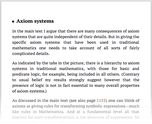
![Basic logic [and axioms] Basic logic [and axioms]](/https/www.wolframscience.com/nks/img/thumbnails/notes-12-9--basic-logic-and-axioms--textonly.png)

![[Axioms for] arithmetic [Axioms for] arithmetic](/https/www.wolframscience.com/nks/img/thumbnails/notes-12-9--axioms-for-arithmetic--textonly.png)
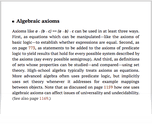
![Groups [and axioms] Groups [and axioms]](/https/www.wolframscience.com/nks/img/thumbnails/notes-12-9--groups-and-axioms--textonly.png)
![Semigroups [and axioms] Semigroups [and axioms]](/https/www.wolframscience.com/nks/img/thumbnails/notes-12-9--semigroups-and-axioms--textonly.png)
![Fields [and axioms] Fields [and axioms]](/https/www.wolframscience.com/nks/img/thumbnails/notes-12-9--fields-and-axioms--textonly.png)
![Rings [and axioms] Rings [and axioms]](/https/www.wolframscience.com/nks/img/thumbnails/notes-12-9--rings-and-axioms--textonly.png)

![Real algebra [and axioms] Real algebra [and axioms]](/https/www.wolframscience.com/nks/img/thumbnails/notes-12-9--real-algebra-and-axioms--textonly.png)
![[Axioms for] geometry [Axioms for] geometry](/https/www.wolframscience.com/nks/img/thumbnails/notes-12-9--axioms-for-geometry--textonly.png)

![Set theory [and axioms] Set theory [and axioms]](/https/www.wolframscience.com/nks/img/thumbnails/notes-12-9--set-theory-and-axioms--textonly.png)
![General topology [and axioms] General topology [and axioms]](/https/www.wolframscience.com/nks/img/thumbnails/notes-12-9--general-topology-and-axioms--textonly.png)
![[Axioms for] real analysis [Axioms for] real analysis](/https/www.wolframscience.com/nks/img/thumbnails/notes-12-9--axioms-for-real-analysis--textonly.png)

![Implementation [of proof example] Implementation [of proof example]](/https/www.wolframscience.com/nks/img/thumbnails/notes-12-9--implementation-of-proof-example--textonly.png)

![Substitution strategies [in proofs] Substitution strategies [in proofs]](/https/www.wolframscience.com/nks/img/thumbnails/notes-12-9--substitution-strategies-in-proofs--textonly.png)
![One-way transformations [as axioms] One-way transformations [as axioms]](/https/www.wolframscience.com/nks/img/thumbnails/notes-12-9--one-way-transformations-as-axioms--textonly.png)

![Reducing axiom [system] details Reducing axiom [system] details](/https/www.wolframscience.com/nks/img/thumbnails/notes-12-9--reducing-axiom-system-details--textonly.png)
![[Mathematical] proofs in practice [Mathematical] proofs in practice](/https/www.wolframscience.com/nks/img/thumbnails/notes-12-9--mathematical-proofs-in-practice--textonly.png)
![Properties [of example multiway systems] Properties [of example multiway systems]](/https/www.wolframscience.com/nks/img/thumbnails/notes-12-9--properties-of-example-multiway-systems-1--textonly.png)

![[Methods for] proof searching [Methods for] proof searching](/https/www.wolframscience.com/nks/img/thumbnails/notes-12-9--methods-for-proof-searching--textonly.png)

![Truth and falsity [in formal systems] Truth and falsity [in formal systems]](/https/www.wolframscience.com/nks/img/thumbnails/notes-12-9--truth-and-falsity-in-formal-systems--textonly.png)
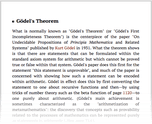
![Properties [of example multiway systems] Properties [of example multiway systems]](/https/www.wolframscience.com/nks/img/thumbnails/notes-12-9--properties-of-example-multiway-systems-2--textonly.png)
![Essential incompleteness [in axiom systems] Essential incompleteness [in axiom systems]](/https/www.wolframscience.com/nks/img/thumbnails/notes-12-9--essential-incompleteness-in-axiom-systems--textonly.png)
![[Universality of] predicate logic [Universality of] predicate logic](/https/www.wolframscience.com/nks/img/thumbnails/notes-12-9--universality-of-predicate-logic--textonly.png)
![[Universality of] algebraic axioms [Universality of] algebraic axioms](/https/www.wolframscience.com/nks/img/thumbnails/notes-12-9--universality-of-algebraic-axioms--textonly.png)
![[Universality of] set theory [Universality of] set theory](/https/www.wolframscience.com/nks/img/thumbnails/notes-12-9--universality-of-set-theory--textonly.png)





![Growth rates [of functions] Growth rates [of functions]](/https/www.wolframscience.com/nks/img/thumbnails/notes-12-9--growth-rates-of-functions--textonly.png)
![[Examples of] unprovable statements [Examples of] unprovable statements](/https/www.wolframscience.com/nks/img/thumbnails/notes-12-9--examples-of-unprovable-statements--textonly.png)
![Encodings of arithmetic [by different operations] Encodings of arithmetic [by different operations]](/https/www.wolframscience.com/nks/img/thumbnails/notes-12-9--encodings-of-arithmetic-by-different-operations--textonly.png)
![[The concept of] infinity [The concept of] infinity](/https/www.wolframscience.com/nks/img/thumbnails/notes-12-9--the-concept-of-infinity--textonly.png)

![Properties [of Diophantine equations] Properties [of Diophantine equations]](/https/www.wolframscience.com/nks/img/thumbnails/notes-12-9--properties-of-diophantine-equations--textonly.png)
![Large solutions [to Diophantine equations] Large solutions [to Diophantine equations]](/https/www.wolframscience.com/nks/img/thumbnails/notes-12-9--large-solutions-to-diophantine-equations--textonly.png)
![Nearby powers [and integer equations] Nearby powers [and integer equations]](/https/www.wolframscience.com/nks/img/thumbnails/notes-12-9--nearby-powers-and-integer-equations--textonly.png)
![Unsolved problems [in number theory] Unsolved problems [in number theory]](/https/www.wolframscience.com/nks/img/thumbnails/notes-12-9--unsolved-problems-in-number-theory--textonly.png)

![More powerful axioms [for mathematics] More powerful axioms [for mathematics]](/https/www.wolframscience.com/nks/img/thumbnails/notes-12-9--more-powerful-axioms-for-mathematics--textonly.png)

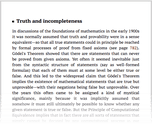


![[Theorems about] practical programs [Theorems about] practical programs](/https/www.wolframscience.com/nks/img/thumbnails/notes-12-9--theorems-about-practical-programs--textonly.png)
![Rules [for multiway systems examples] Rules [for multiway systems examples]](/https/www.wolframscience.com/nks/img/thumbnails/notes-12-9--rules-for-multiway-systems-examples--textonly.png)
![Consistency [in axiom systems] Consistency [in axiom systems]](/https/www.wolframscience.com/nks/img/thumbnails/notes-12-9--consistency-in-axiom-systems--textonly.png)
![Properties [of example multiway systems] Properties [of example multiway systems]](/https/www.wolframscience.com/nks/img/thumbnails/notes-12-9--properties-of-example-multiway-systems-3--textonly.png)

![[Unprovable statements in] reduced arithmetic [Unprovable statements in] reduced arithmetic](/https/www.wolframscience.com/nks/img/thumbnails/notes-12-9--unprovable-statements-in-reduced-arithmetic--textonly.png)
![Generators and relations [and axiom systems] Generators and relations [and axiom systems]](/https/www.wolframscience.com/nks/img/thumbnails/notes-12-9--generators-and-relations-and-axiom-systems--textonly.png)


![[History of] truth tables [History of] truth tables](/https/www.wolframscience.com/nks/img/thumbnails/notes-12-9--history-of-truth-tables--textonly.png)





![Implementation [of operators from axioms] Implementation [of operators from axioms]](/https/www.wolframscience.com/nks/img/thumbnails/notes-12-9--implementation-of-operators-from-axioms--textonly.png)
![Properties [of operators from axioms] Properties [of operators from axioms]](/https/www.wolframscience.com/nks/img/thumbnails/notes-12-9--properties-of-operators-from-axioms--textonly.png)
![Algebraic systems [and operator systems] Algebraic systems [and operator systems]](/https/www.wolframscience.com/nks/img/thumbnails/notes-12-9--algebraic-systems-and-operator-systems--textonly.png)
![Symbolic systems [and operator systems] Symbolic systems [and operator systems]](/https/www.wolframscience.com/nks/img/thumbnails/notes-12-9--symbolic-systems-and-operator-systems--textonly.png)
![Groups and semigroups [and operator systems] Groups and semigroups [and operator systems]](/https/www.wolframscience.com/nks/img/thumbnails/notes-12-9--groups-and-semigroups-and-operator-systems--textonly.png)
![Forcing of operators [by axiom systems] Forcing of operators [by axiom systems]](/https/www.wolframscience.com/nks/img/thumbnails/notes-12-9--forcing-of-operators-by-axiom-systems--textonly.png)


![Multiway systems [and operator systems] Multiway systems [and operator systems]](/https/www.wolframscience.com/nks/img/thumbnails/notes-12-9--multiway-systems-and-operator-systems--textonly.png)

![Properties [of logical primitives] Properties [of logical primitives]](/https/www.wolframscience.com/nks/img/thumbnails/notes-12-9--properties-of-logical-primitives--textonly.png)
![Notations [for logical primitives] Notations [for logical primitives]](/https/www.wolframscience.com/nks/img/thumbnails/notes-12-9--notations-for-logical-primitives--textonly.png)

![Searching for logic [axioms] Searching for logic [axioms]](/https/www.wolframscience.com/nks/img/thumbnails/notes-12-9--searching-for-logic-axioms--textonly.png)
![Two-operator logic [axioms] Two-operator logic [axioms]](/https/www.wolframscience.com/nks/img/thumbnails/notes-12-9--two-operator-logic-axioms--textonly.png)
![History [of logic axioms] History [of logic axioms]](/https/www.wolframscience.com/nks/img/thumbnails/notes-12-9--history-of-logic-axioms--textonly.png)
![Theorem distributions [in standard mathematics] Theorem distributions [in standard mathematics]](/https/www.wolframscience.com/nks/img/thumbnails/notes-12-9--theorem-distributions-in-standard-mathematics--textonly.png)





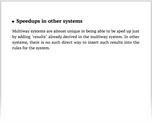


![Ordering of [mathematical] constructs Ordering of [mathematical] constructs](/https/www.wolframscience.com/nks/img/thumbnails/notes-12-9--ordering-of-mathematical-constructs--textonly.png)

![Frameworks [in mathematics] Frameworks [in mathematics]](/https/www.wolframscience.com/nks/img/thumbnails/notes-12-9--frameworks-in-mathematics--textonly.png)









![History [of extraterrestrial life] History [of extraterrestrial life]](/https/www.wolframscience.com/nks/img/thumbnails/notes-12-10--history-of-extraterrestrial-life--textonly.png)






![[Ideas of] meaning in programs [Ideas of] meaning in programs](/https/www.wolframscience.com/nks/img/thumbnails/notes-12-10--ideas-of-meaning-in-programs--textonly.png)

![Forms of [engineered] artifacts Forms of [engineered] artifacts](/https/www.wolframscience.com/nks/img/thumbnails/notes-12-10--forms-of-engineered-artifacts--textonly.png)
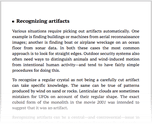
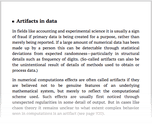
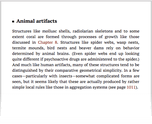
![[Meaning in] molecular biology [Meaning in] molecular biology](/https/www.wolframscience.com/nks/img/thumbnails/notes-12-10--meaning-in-molecular-biology--textonly.png)

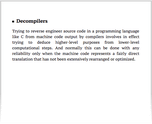

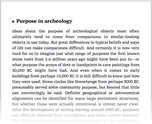
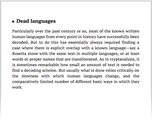

![Possible purposes [for systems] Possible purposes [for systems]](/https/www.wolframscience.com/nks/img/thumbnails/notes-12-10--possible-purposes-for-systems--textonly.png)

![Doubling rules [cellular automata] Doubling rules [cellular automata]](/https/www.wolframscience.com/nks/img/thumbnails/notes-12-10--doubling-rules-cellular-automata--textonly.png)
![Searching [for doubling rules] Searching [for doubling rules]](/https/www.wolframscience.com/nks/img/thumbnails/notes-12-10--searching-for-doubling-rules--textonly.png)
![Properties [of doubling rules] Properties [of doubling rules]](/https/www.wolframscience.com/nks/img/thumbnails/notes-12-10--properties-of-doubling-rules--textonly.png)
![[Rules implementing] other functions [Rules implementing] other functions](/https/www.wolframscience.com/nks/img/thumbnails/notes-12-10--rules-implementing-other-functions--textonly.png)

![Other examples [of minimal systems] Other examples [of minimal systems]](/https/www.wolframscience.com/nks/img/thumbnails/notes-12-10--other-examples-of-minimal-systems--textonly.png)





![[History of] SETI [History of] SETI](/https/www.wolframscience.com/nks/img/thumbnails/notes-12-10--history-of-seti--textonly.png)
![Detection methods [for SETI] Detection methods [for SETI]](/https/www.wolframscience.com/nks/img/thumbnails/notes-12-10--detection-methods-for-seti--textonly.png)

![Messages to send [to extraterrestrials] Messages to send [to extraterrestrials]](/https/www.wolframscience.com/nks/img/thumbnails/notes-12-10--messages-to-send-to-extraterrestrials--textonly.png)
![P versus NP [and messages] P versus NP [and messages]](/https/www.wolframscience.com/nks/img/thumbnails/notes-12-10--p-versus-np-and-messages--textonly.png)
![Science fiction [and extraterrestrials] Science fiction [and extraterrestrials]](/https/www.wolframscience.com/nks/img/thumbnails/notes-12-10--science-fiction-and-extraterrestrials--textonly.png)
![Practical arguments [about exterrestrials] Practical arguments [about exterrestrials]](/https/www.wolframscience.com/nks/img/thumbnails/notes-12-10--practical-arguments-about-exterrestrials--textonly.png)

![Covering [implications for] technology Covering [implications for] technology](/https/www.wolframscience.com/nks/img/thumbnails/notes-12-11--covering-implications-for-technology--textonly.png)





![[Implications for] chemistry [Implications for] chemistry](/https/www.wolframscience.com/nks/img/thumbnails/notes-12-11--implications-for-chemistry--textonly.png)
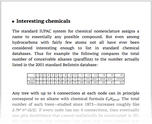









![Microcosm [and PCE] Microcosm [and PCE]](/https/www.wolframscience.com/nks/img/thumbnails/notes-12-12--microcosm-and-pce--textonly.png)

